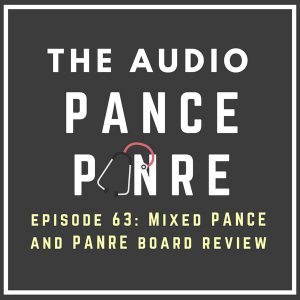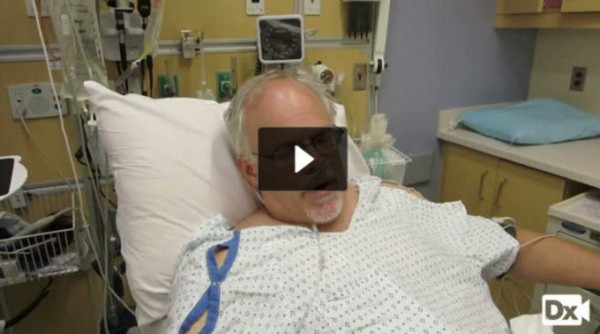Offline dengan aplikasi Player FM !
Episode 63: The Audio PANCE and PANRE – Ten Mixed NCCPA™ Content Blueprint Multiple Choice Questions
Manage episode 214636816 series 97199
Ten Mixed NCCPA PANCE Content Blueprint Multiple Choice Questions
PANCE Content Blueprint Multiple Choice Questions
Welcome to episode 63 of the FREE Audio PANCE and PANRE Physician Assistant Board Review Podcast.
Join me as I cover ten PANCE and PANRE Board review questions from the SMARTYPANCE course content following the NCCPA content blueprint (download the FREE cheat sheet).
content blueprint (download the FREE cheat sheet).
This week we will be covering ten general board review questions based on the NCCPA PANCE and PANRE Content Blueprint.
Below you will find an interactive exam to complement the podcast.
I hope you enjoy this free audio component to the examination portion of this site. The full board review includes over 2,000 interactive board review questions and is available to all members of the PANCE and PANRE Academy and SMARTYPANCE which are now bundled together into one very low price.
- You can download and listen to past FREE episodes here, on iTunes, on Google Play Music or Stitcher Radio.
- You can listen to the latest episode, take an interactive quiz and download your results below.
Listen Carefully Then Take The Practice Exam
If you can’t see the audio player click here to listen to the full episode.
Episode 63 – General PANCE/PANRE Podcast Quiz
The following 10 questions are linked to NCCPA Content Blueprint lessons from the SMARTYPANCE and PANRE Board review website. If you are a member you will be able to log in and view this interactive video content.
1. A 24-year-old male presents complaining of a 9-month history of increasing shortness of breath, dyspnea on exertion, and a cough productive of white sputum, mostly in the mornings. He denies orthopnea, PND, peripheral edema, fever, chills, night sweats, recent changes in weight, palpitations, chest pain, food intolerances, or other complaints. Patient has a history of recurrent lung infections. He states that his father had chronic pulmonary problems and died at age 42 from unknown lung disease. The patient denies smoking, alcohol or illicit drug use. On physical examination, the respiratory rate is 22 breaths per minute, a pulse of 98 bpm, a temperature of 98.7 degrees. Pulmonary exam reveals end-expiratory wheezes bilaterally and hyperresonance to percussion. His cardiac exam is normal. Chest X-ray shows decreased lung markings. ECG is normal. Pulmonary function tests show an FEV1 63% of expected and residual capacity is 123% of expected. Which of the following is the most likely diagnosis?
A. Emphysema
B. Pulmonary fibrosis
C. Ventricular septal defect
D. Congestive heart failure
Answer: A. Emphysema
This person has an obstructive lung disease based on PFTs. Emphysema is the most likely diagnosis and may be related to alpha-1 antitrypsin deficiency based on family history and lack of smoking history and young age.
Emphysema is covered as part of the NCCPA Pulmonary Blueprint (12%)
B. The PFTs from a person with pulmonary fibrosis would be consistent with a restrictive pattern. This patient has an obstructive pattern of lung disease.
C. Ventricular septal defect will have a systolic murmur associated with it.
D. Congestive heart failure might explain some of the symptoms of this patient (increasing shortness of breath and DOE), he denies other common symptoms, such as orthopnea and peripheral edema. CHF should not result in changes in the PFTs.
2. A male patient complains of chronic dysuria, frequency, and urgency with associated perineal pain. The most likely diagnosis is
A. cystitis
B. gonococcal urethritis
C. epididymitis
D. prostatitis
Answer: D. prostatitis
Some patients are asymptomatic, but low back or perineal pain, fever, chills, and irritative urinary symptoms are common in prostatitis.
Prostatitis is covered as part of the NCCPA PANCE Genitourinary Blueprint
A. Cystitis is characterized by dysuria without urethral discharge.
B. Initially, there is burning on urination and serous or milky discharge in gonococcal urethritis.
C. Epididymitis is characterized by dysuria, unilateral scrotal pain, and swelling.
3. Which of the following preventive strategies against osteoporosis-associated vertebral fractures has a known side effect of increasing the incidence of hot flashes when used in a perimenopausal female?
A. Calcitonin (Miacalcin) nasal spray
B. Alendronate (Fosamax)
C. Estrogen/progesterone (Prempro)replacement
D. Raloxifene (Evista)
Osteoporosis is covered as part of the PANCE Musculoskeletal Blueprint
Answer: D. Raloxifene (Evista)
Raloxifene has effects on bone turnover and bone mass and has been shown to decrease vertebral fractures. It has anti-estrogen effects on the non-skeletal portions of the body and increases hot flashes in perimenopausal females.
A. Calcitonin does not have any estrogen effects on the body and serves as an analgesic when used in the management of vertebral fractures.
B. Alendronate is a bisphosphonate that does not have any hormonal effects on the body.
C. Estrogen/progesterone replacement has the benefit of maintaining bone and decreasing vertebral fractures but it would improve perimenopausal hot flashes.
4. A 70-year-old presents with a headache and neck stiffness. On physical exam, the patient is febrile, Kernig’s sign is present, and no rash is noted. A spinal tap reveals a white count of 250/cm3 with 100% neutrophils, total protein 250mg/dL, and glucose 35 mg/dL. Which of the following is the most appropriate treatment?
A. Acyclovir (Zovirax)
B. Fluconazole (Diflucan)
C. Ampicillin and ceftriaxone (Rocephin)
D. Penicillin and chloramphenicol (Chloromycetin)
Bacterial meningitis is covered as part of the PANCE Neurology Blueprint
Answer: C. Ampicillin and ceftriaxone (Rocephin)
Ampicillin and ceftriaxone are used to treat bacterial meningitis, secondary to Listeria monocytogenes, which is common in the elderly. Ceftriaxone will cover other common etiologic agents such as Streptococcal pneumonia
A. Acyclovir is used to treat meningitis secondary to herpes. Viral meningitis presents with an increased number of lymphocytes and elevated glucose in the CSF.
B. Fluconazole is used to treat fungal meningitis. Fungal meningitis, typically noted in immunocompromised hosts, presents with an increased number of lymphocytes in the CSF.
D. Penicillin and chloramphenicol is used to treat bacterial meningitis, secondary to Neisseria meningitidis. Bacterial meningitis due to N
5. A 45-year-old patient with type 1 diabetes mellitus is being screened for diabetic nephropathy. Which of the following urinalysis findings is most consistent with early diabetic nephropathy?
A. Microalbuminuria
B. Red cell casts
C. White cell casts
D. Renal epithelial cells
Diabetic neuropathy is covered as part of the PANCE Endocrinology Blueprint
Answer: A. Microalbuminuria
Microalbuminuria is most consistent with early diabetic neuropathy.
B. Red cell casts are more indicative of acute glomerular nephritis.
C. White cell casts are more consistent with acute pyelonephritis.
D. A few renal epithelial cells normally may be found in the urine.
6. A 74-year-old female is being treated for mild hypertension. She is found at home with right hemiparesis and brought to the emergency department. Her daughter states that the patient fell in her kitchen 2 days ago, but had no complaints at that time. She did state that her mother sounded a little confused this morning. The patient’s left pupil is dilated. Which of the following diagnostic studies should be ordered first?
A. MRI of the brain
B. CT scan of the brain
C. Skull x-ray
D. Lumbar puncture
Answer: B. CT scan of the brain
This patient presents with a history of minor trauma and progressive neurological abnormalities consistent with subdural hematoma. Diagnosis would be confirmed by CT scan, which is less expensive and more sensitive for blood than an MRI.
Intracranial Hemorrhage is covered as part of the PANCE Neurology Blueprint
C. Skull x-rays would not be helpful because they evaluate bony, not soft tissue, injury.
D. A lumbar puncture is contraindicated because of the potential for brain herniation.
7. A post-op patient has signs and symptoms highly suggestive of a pulmonary embolism. The results of the CT scan of the lung is nondiagnostic. What is the most appropriate next step in the evaluation?
A. Ventilation-perfusion (V/Q) scan
B. Ultrasound of the legs
C. Echocardiography
D. D-dimer
Pulmonary embolism and is part of the PANCE Pulmonary Blueprint
Answer: B. Ultrasound of the legs
In a patient with a high likelihood of pulmonary embolism or an inpatient, as in this case, ultrasound of the legs would be the next diagnostic step after a nondiagnostic CT.
A. Ventilation-perfusion scans are performed prior to the CT scan of the chest and would not likely add additional information to this clinical scenario.
C. Although echocardiography may show right ventricular free wall hypokinesis with normal motion of the apex suggestive of pulmonary embolism, more than 50% of patients with a pulmonary embolism will have normal echocardiography. Echocardiography is not used in the diagnosis of inpatients.
D. In a post-op patient, a d-dimer will be positive regardless of the presence or absence of a pulmonary embolism.
8. Seizures that first manifest in early to middle adult life should be considered suspicious of which of the following causes?
A. Cerebrovascular disease
B. Encephalitis
C. Tumor
D. Idiopathic epilepsy
Seizure disorders are covered as part of the PANCE Neurology Blueprint
Answer: C. Tumor
Seizures that develop during adolescence and adult life are predominantly due to tumor, trauma, drug use, or alcohol withdrawal.
9. Which of the following medications used in the treatment of supraventricular tachycardia is able to cause sinus arrest and asystole for a few seconds while it breaks the paroxysmal supraventricular tachycardia?
A. Digoxin (Lanoxin)
B. Adenosine (Adenocard)
C. Verapamil (Calan)
D. Quinidine (Quinaglute)
Paroxysmal supraventricular tachycardia is covered as part of the PANCE Cardiology Blueprint
Answer: B. Adenosine (Adenocard)
Adenosine is an endogenous nucleoside that results in profound (although transient) slowing of the AV conduction and sinus node discharge rate. This agent has a very short half-life of 6 seconds.
A. Digoxin is not used for the acute termination of supraventricular tachycardia.
C. Although verapamil may be used for the termination of acute supraventricular tachycardia, it does not lead to sinus arrest in therapeutic doses.
D. Quinidine is rarely used today and is not indicated for the termination of supraventricular tachycardia.
10. A 32-year-old presents with a 3-day history of diarrhea. The patient denies blood, mucus, or night awakening with diarrhea. He recently returned from a business trip to Canada. On physical examination, the patient is afebrile and vital signs reveal BP 115/80, the pulse is 76, and respirations are 14. The abdominal examination reveals hyperactive bowel sounds but is otherwise unremarkable. Which of the following is the most appropriate initial intervention?
A. Stool for culture, ova, and parasites
B. Proctosigmoidoscopy
C. Metronidazole (Flagyl)
D. Supportive treatment
Infectious and Noninfectious Diarrhea are covered as part of the NCCPA PANCE GI and Nutrition Blueprint
Answer: D. Supportive treatment
Symptomatic treatment, including dietary management and over-the-counter antidiarrheals, is indicated for afebrile patients with watery diarrhea of less than 5 days duration.
A. Stool culture and examination for ova and parasites are indicated when diarrhea has persisted longer than 3 weeks or is associated with abdominal pain, fever, and/or bloody stools.
B. Proctosigmoidoscopy is indicated when inflammatory bowel disease is suspected on the basis of fever, bloody diarrhea, or abdominal pain.
C. Metronidazole is indicated with a confirmed diagnosis of Giardia lamblia or amebic disease.
Looking for all the podcast episodes?
This FREE series is limited to every other episode, you can download and enjoy the complete audio series by joining The PANCE and PANRE Exam Academy + SMARTYPANCE
I will be releasing new episodes every few weeks. The Academy is discounted, so sign up now.
Resources and Links From The Show
- My list of recommended PANCE and PANRE review books
- Download the FREE PANCE and PANRE Blueprint Checklist
- Sign up for the FREE daily PANCE and PANRE email series
- Join the Smarty PANCE NCCPA Content Blueprint Website + The PA Life Academy
- Get 20% of any Picmonic membership by using this link
- Use Code “PALIFE” and get 10% OFF THE RUTGERS PANCE AND PANRE REVIEW COURSE
This Podcast is also available on iTunes and Stitcher Radio for Android
- iTunes: The Audio PANCE AND PANRE Podcast iTunes
- Stitcher Radio: The Audio PANCE and PANRE Podcast Stitcher
Download The Content Blueprint Checklist
Follow this link to download your FREE copy of the Content Blueprint Checklist
Print it up and start crossing out the topics you understand, marking the ones you don’t and making notes of key terms you should remember. The PDF version is interactive and linked directly to the individual lessons on SMARTY PANCE.
The post Episode 63: The Audio PANCE and PANRE – Ten Mixed NCCPA™ Content Blueprint Multiple Choice Questions appeared first on The Audio PANCE and PANRE.
68 episode
Episode 63: The Audio PANCE and PANRE – Ten Mixed NCCPA™ Content Blueprint Multiple Choice Questions
The Audio PANCE and PANRE Physician Assistant Board Review Podcast
Manage episode 214636816 series 97199
Ten Mixed NCCPA PANCE Content Blueprint Multiple Choice Questions
PANCE Content Blueprint Multiple Choice Questions
Welcome to episode 63 of the FREE Audio PANCE and PANRE Physician Assistant Board Review Podcast.
Join me as I cover ten PANCE and PANRE Board review questions from the SMARTYPANCE course content following the NCCPA content blueprint (download the FREE cheat sheet).
content blueprint (download the FREE cheat sheet).
This week we will be covering ten general board review questions based on the NCCPA PANCE and PANRE Content Blueprint.
Below you will find an interactive exam to complement the podcast.
I hope you enjoy this free audio component to the examination portion of this site. The full board review includes over 2,000 interactive board review questions and is available to all members of the PANCE and PANRE Academy and SMARTYPANCE which are now bundled together into one very low price.
- You can download and listen to past FREE episodes here, on iTunes, on Google Play Music or Stitcher Radio.
- You can listen to the latest episode, take an interactive quiz and download your results below.
Listen Carefully Then Take The Practice Exam
If you can’t see the audio player click here to listen to the full episode.
Episode 63 – General PANCE/PANRE Podcast Quiz
The following 10 questions are linked to NCCPA Content Blueprint lessons from the SMARTYPANCE and PANRE Board review website. If you are a member you will be able to log in and view this interactive video content.
1. A 24-year-old male presents complaining of a 9-month history of increasing shortness of breath, dyspnea on exertion, and a cough productive of white sputum, mostly in the mornings. He denies orthopnea, PND, peripheral edema, fever, chills, night sweats, recent changes in weight, palpitations, chest pain, food intolerances, or other complaints. Patient has a history of recurrent lung infections. He states that his father had chronic pulmonary problems and died at age 42 from unknown lung disease. The patient denies smoking, alcohol or illicit drug use. On physical examination, the respiratory rate is 22 breaths per minute, a pulse of 98 bpm, a temperature of 98.7 degrees. Pulmonary exam reveals end-expiratory wheezes bilaterally and hyperresonance to percussion. His cardiac exam is normal. Chest X-ray shows decreased lung markings. ECG is normal. Pulmonary function tests show an FEV1 63% of expected and residual capacity is 123% of expected. Which of the following is the most likely diagnosis?
A. Emphysema
B. Pulmonary fibrosis
C. Ventricular septal defect
D. Congestive heart failure
Answer: A. Emphysema
This person has an obstructive lung disease based on PFTs. Emphysema is the most likely diagnosis and may be related to alpha-1 antitrypsin deficiency based on family history and lack of smoking history and young age.
Emphysema is covered as part of the NCCPA Pulmonary Blueprint (12%)
B. The PFTs from a person with pulmonary fibrosis would be consistent with a restrictive pattern. This patient has an obstructive pattern of lung disease.
C. Ventricular septal defect will have a systolic murmur associated with it.
D. Congestive heart failure might explain some of the symptoms of this patient (increasing shortness of breath and DOE), he denies other common symptoms, such as orthopnea and peripheral edema. CHF should not result in changes in the PFTs.
2. A male patient complains of chronic dysuria, frequency, and urgency with associated perineal pain. The most likely diagnosis is
A. cystitis
B. gonococcal urethritis
C. epididymitis
D. prostatitis
Answer: D. prostatitis
Some patients are asymptomatic, but low back or perineal pain, fever, chills, and irritative urinary symptoms are common in prostatitis.
Prostatitis is covered as part of the NCCPA PANCE Genitourinary Blueprint
A. Cystitis is characterized by dysuria without urethral discharge.
B. Initially, there is burning on urination and serous or milky discharge in gonococcal urethritis.
C. Epididymitis is characterized by dysuria, unilateral scrotal pain, and swelling.
3. Which of the following preventive strategies against osteoporosis-associated vertebral fractures has a known side effect of increasing the incidence of hot flashes when used in a perimenopausal female?
A. Calcitonin (Miacalcin) nasal spray
B. Alendronate (Fosamax)
C. Estrogen/progesterone (Prempro)replacement
D. Raloxifene (Evista)
Osteoporosis is covered as part of the PANCE Musculoskeletal Blueprint
Answer: D. Raloxifene (Evista)
Raloxifene has effects on bone turnover and bone mass and has been shown to decrease vertebral fractures. It has anti-estrogen effects on the non-skeletal portions of the body and increases hot flashes in perimenopausal females.
A. Calcitonin does not have any estrogen effects on the body and serves as an analgesic when used in the management of vertebral fractures.
B. Alendronate is a bisphosphonate that does not have any hormonal effects on the body.
C. Estrogen/progesterone replacement has the benefit of maintaining bone and decreasing vertebral fractures but it would improve perimenopausal hot flashes.
4. A 70-year-old presents with a headache and neck stiffness. On physical exam, the patient is febrile, Kernig’s sign is present, and no rash is noted. A spinal tap reveals a white count of 250/cm3 with 100% neutrophils, total protein 250mg/dL, and glucose 35 mg/dL. Which of the following is the most appropriate treatment?
A. Acyclovir (Zovirax)
B. Fluconazole (Diflucan)
C. Ampicillin and ceftriaxone (Rocephin)
D. Penicillin and chloramphenicol (Chloromycetin)
Bacterial meningitis is covered as part of the PANCE Neurology Blueprint
Answer: C. Ampicillin and ceftriaxone (Rocephin)
Ampicillin and ceftriaxone are used to treat bacterial meningitis, secondary to Listeria monocytogenes, which is common in the elderly. Ceftriaxone will cover other common etiologic agents such as Streptococcal pneumonia
A. Acyclovir is used to treat meningitis secondary to herpes. Viral meningitis presents with an increased number of lymphocytes and elevated glucose in the CSF.
B. Fluconazole is used to treat fungal meningitis. Fungal meningitis, typically noted in immunocompromised hosts, presents with an increased number of lymphocytes in the CSF.
D. Penicillin and chloramphenicol is used to treat bacterial meningitis, secondary to Neisseria meningitidis. Bacterial meningitis due to N
5. A 45-year-old patient with type 1 diabetes mellitus is being screened for diabetic nephropathy. Which of the following urinalysis findings is most consistent with early diabetic nephropathy?
A. Microalbuminuria
B. Red cell casts
C. White cell casts
D. Renal epithelial cells
Diabetic neuropathy is covered as part of the PANCE Endocrinology Blueprint
Answer: A. Microalbuminuria
Microalbuminuria is most consistent with early diabetic neuropathy.
B. Red cell casts are more indicative of acute glomerular nephritis.
C. White cell casts are more consistent with acute pyelonephritis.
D. A few renal epithelial cells normally may be found in the urine.
6. A 74-year-old female is being treated for mild hypertension. She is found at home with right hemiparesis and brought to the emergency department. Her daughter states that the patient fell in her kitchen 2 days ago, but had no complaints at that time. She did state that her mother sounded a little confused this morning. The patient’s left pupil is dilated. Which of the following diagnostic studies should be ordered first?
A. MRI of the brain
B. CT scan of the brain
C. Skull x-ray
D. Lumbar puncture
Answer: B. CT scan of the brain
This patient presents with a history of minor trauma and progressive neurological abnormalities consistent with subdural hematoma. Diagnosis would be confirmed by CT scan, which is less expensive and more sensitive for blood than an MRI.
Intracranial Hemorrhage is covered as part of the PANCE Neurology Blueprint
C. Skull x-rays would not be helpful because they evaluate bony, not soft tissue, injury.
D. A lumbar puncture is contraindicated because of the potential for brain herniation.
7. A post-op patient has signs and symptoms highly suggestive of a pulmonary embolism. The results of the CT scan of the lung is nondiagnostic. What is the most appropriate next step in the evaluation?
A. Ventilation-perfusion (V/Q) scan
B. Ultrasound of the legs
C. Echocardiography
D. D-dimer
Pulmonary embolism and is part of the PANCE Pulmonary Blueprint
Answer: B. Ultrasound of the legs
In a patient with a high likelihood of pulmonary embolism or an inpatient, as in this case, ultrasound of the legs would be the next diagnostic step after a nondiagnostic CT.
A. Ventilation-perfusion scans are performed prior to the CT scan of the chest and would not likely add additional information to this clinical scenario.
C. Although echocardiography may show right ventricular free wall hypokinesis with normal motion of the apex suggestive of pulmonary embolism, more than 50% of patients with a pulmonary embolism will have normal echocardiography. Echocardiography is not used in the diagnosis of inpatients.
D. In a post-op patient, a d-dimer will be positive regardless of the presence or absence of a pulmonary embolism.
8. Seizures that first manifest in early to middle adult life should be considered suspicious of which of the following causes?
A. Cerebrovascular disease
B. Encephalitis
C. Tumor
D. Idiopathic epilepsy
Seizure disorders are covered as part of the PANCE Neurology Blueprint
Answer: C. Tumor
Seizures that develop during adolescence and adult life are predominantly due to tumor, trauma, drug use, or alcohol withdrawal.
9. Which of the following medications used in the treatment of supraventricular tachycardia is able to cause sinus arrest and asystole for a few seconds while it breaks the paroxysmal supraventricular tachycardia?
A. Digoxin (Lanoxin)
B. Adenosine (Adenocard)
C. Verapamil (Calan)
D. Quinidine (Quinaglute)
Paroxysmal supraventricular tachycardia is covered as part of the PANCE Cardiology Blueprint
Answer: B. Adenosine (Adenocard)
Adenosine is an endogenous nucleoside that results in profound (although transient) slowing of the AV conduction and sinus node discharge rate. This agent has a very short half-life of 6 seconds.
A. Digoxin is not used for the acute termination of supraventricular tachycardia.
C. Although verapamil may be used for the termination of acute supraventricular tachycardia, it does not lead to sinus arrest in therapeutic doses.
D. Quinidine is rarely used today and is not indicated for the termination of supraventricular tachycardia.
10. A 32-year-old presents with a 3-day history of diarrhea. The patient denies blood, mucus, or night awakening with diarrhea. He recently returned from a business trip to Canada. On physical examination, the patient is afebrile and vital signs reveal BP 115/80, the pulse is 76, and respirations are 14. The abdominal examination reveals hyperactive bowel sounds but is otherwise unremarkable. Which of the following is the most appropriate initial intervention?
A. Stool for culture, ova, and parasites
B. Proctosigmoidoscopy
C. Metronidazole (Flagyl)
D. Supportive treatment
Infectious and Noninfectious Diarrhea are covered as part of the NCCPA PANCE GI and Nutrition Blueprint
Answer: D. Supportive treatment
Symptomatic treatment, including dietary management and over-the-counter antidiarrheals, is indicated for afebrile patients with watery diarrhea of less than 5 days duration.
A. Stool culture and examination for ova and parasites are indicated when diarrhea has persisted longer than 3 weeks or is associated with abdominal pain, fever, and/or bloody stools.
B. Proctosigmoidoscopy is indicated when inflammatory bowel disease is suspected on the basis of fever, bloody diarrhea, or abdominal pain.
C. Metronidazole is indicated with a confirmed diagnosis of Giardia lamblia or amebic disease.
Looking for all the podcast episodes?
This FREE series is limited to every other episode, you can download and enjoy the complete audio series by joining The PANCE and PANRE Exam Academy + SMARTYPANCE
I will be releasing new episodes every few weeks. The Academy is discounted, so sign up now.
Resources and Links From The Show
- My list of recommended PANCE and PANRE review books
- Download the FREE PANCE and PANRE Blueprint Checklist
- Sign up for the FREE daily PANCE and PANRE email series
- Join the Smarty PANCE NCCPA Content Blueprint Website + The PA Life Academy
- Get 20% of any Picmonic membership by using this link
- Use Code “PALIFE” and get 10% OFF THE RUTGERS PANCE AND PANRE REVIEW COURSE
This Podcast is also available on iTunes and Stitcher Radio for Android
- iTunes: The Audio PANCE AND PANRE Podcast iTunes
- Stitcher Radio: The Audio PANCE and PANRE Podcast Stitcher
Download The Content Blueprint Checklist
Follow this link to download your FREE copy of the Content Blueprint Checklist
Print it up and start crossing out the topics you understand, marking the ones you don’t and making notes of key terms you should remember. The PDF version is interactive and linked directly to the individual lessons on SMARTY PANCE.
The post Episode 63: The Audio PANCE and PANRE – Ten Mixed NCCPA™ Content Blueprint Multiple Choice Questions appeared first on The Audio PANCE and PANRE.
68 episode
Semua episode
×Selamat datang di Player FM!
Player FM memindai web untuk mencari podcast berkualitas tinggi untuk Anda nikmati saat ini. Ini adalah aplikasi podcast terbaik dan bekerja untuk Android, iPhone, dan web. Daftar untuk menyinkronkan langganan di seluruh perangkat.










